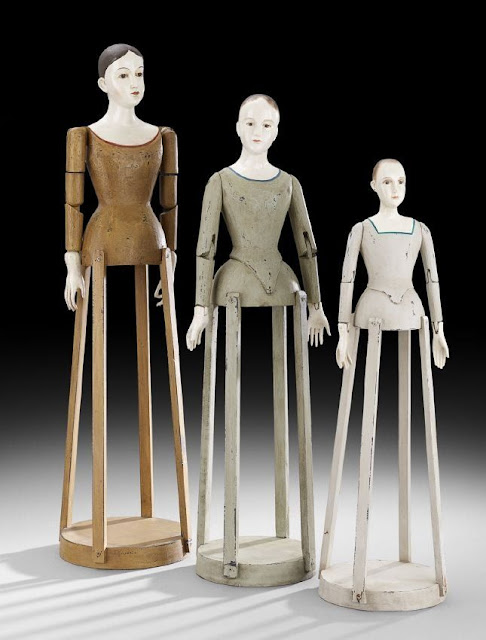You have seen them..... silently watching over a collection of brocante items lovingly arranged atop tables and shelves in a rustic French Provincial farmhouse. They are called Santos cage dolls and after becoming more and more popular over the past few years, they now are enthusiastically sought after by collectors and designers that want to add old world style to their homes.
Originally started as copies of 17th century carvings by priests and called saint dolls or Santons in French, Santibelli in Italian, and Santos in Spanish, cage dolls are primarily associated with the Italian and French Crèche (nativity and crib scenes). They were used as forms for decorating the Crèche and are still elaborately displayed in Italy and in the Provence area of France. The term cage-doll is due to the bottom portion of the body resembling a cage.
Skillfully hand made of solid hardwood with polychrome paint and gilt, these dolls have a long and deep religious history. Their use dates back centuries when they were a crucial part of in-home altars in small, rural villages. These villages were without churches and access to priests so the cage doll statues were used as replacement altars and in Catholic religious processions. Their development flourished in Europe in the 1700's and 1800's, primarily due to wars. These icons were crucial in the quest to Christianize not only the peoples of Europe but even into the Americas.
Skillfully hand made of solid hardwood with polychrome paint and gilt, these dolls have a long and deep religious history. Their use dates back centuries when they were a crucial part of in-home altars in small, rural villages. These villages were without churches and access to priests so the cage doll statues were used as replacement altars and in Catholic religious processions. Their development flourished in Europe in the 1700's and 1800's, primarily due to wars. These icons were crucial in the quest to Christianize not only the peoples of Europe but even into the Americas.
It is getting hard to find original cage dolls and they can be very expensive. However, reproductions that are fashioned after antique originals are becoming more common. They too are usually hand carved and hand painted and their understated beauty can be an asset to any interior.
via Pinterest
The Santos cage dolls are a part of what is called Saint Art which consists of carvings in ivory or wood of various and plentiful Catholic saints, angels, or the Virgin Mary.
These iconic religious figures have been adored throughout history and would occupy a place of prominence in the home.
via Pinterest
I am Protestant but am still looking for a cage doll to mix in with some more French pieces just because I think they are lovely. The cage doll is not relegated to religious symbols so feel free to enjoy them for their historical as well as aesthetic value.
zsazsabellagio.com
zsazsabellagio.com
bittersweetdesigns.com
Here is an example of two kinds of Santos dolls, the traditional style and the cage style which is actually called a bastidor doll, bastidor meaning “frame” or “framework. It is like the traditional from the torso up but has the cage on the bottom.
Here is an example of two kinds of Santos dolls, the traditional style and the cage style which is actually called a bastidor doll, bastidor meaning “frame” or “framework. It is like the traditional from the torso up but has the cage on the bottom.
This cage framework would usually be covered with cloth made to resemble the figure’s skirt. Originally the cage would also serve as storage for religious relics or other small trinkets.
via Pinterest
Santos cage dolls are most often rustic in nature, yet with delicate details.Their serene faces are what makes them so charming.
Wonderful whitewashed Santos cage dolls like this one were frequently dressed in elaborate gowns or ornate religious garb, often topped with golden crowns, and used in Catholic religious processions.
Mix the Santos cage dolls in with some more traditional or French pieces for a beautiful old world look. Many people find them a bit eerie when standing alone so adding in other items seems to change their minds.
Antique cage dolls frequently have glass eyes, while reproductions usually have beautifully detailed painted eyes.
While painted in colors like pink, brown, ocher, and sienna, blue is the most common color used to paint the bodies of Santos cage dolls.
Another great feature of the cage doll is the articulation of the arms. This makes it easier to dress in lavish garments for use in religious ceremonies and also allows it to be positioned in various poses.
The visible parts of these images such as the head and hands are usually carved in wood, covered with a fine layer of stucco, and delicately poly-chromed. The arms and forearms are joined to the body by wires and the trunk is attached to the skirt with nails.
Collectors scour French flea markets for Santos crowns. They are sought after decorative items for dressing a cage doll.
Iris Apfel's NYC apartment via Architectural Digest
Cage dolls are one of those items that just looks good in a vignette .........of any style from antique to modern.
Veranda Magazine
Santos cage dolls are especially lovely at Christmas as they work well with other figures involved in a tabletop Crèche.
Many people dress their cage dolls as angels during this time of year.
via Pinterest
My favorite way to display Santos cage dolls is in their simple unadorned state. However you choose to display yours the result will be the same......a source of serenity and charm for your home.
Click here to see the previous post
http://eyefordesignlfd.blogspot.com/2017/06/decorating-with-art-deco-inspired.html
This blog post was published by Lisa Farmer





























